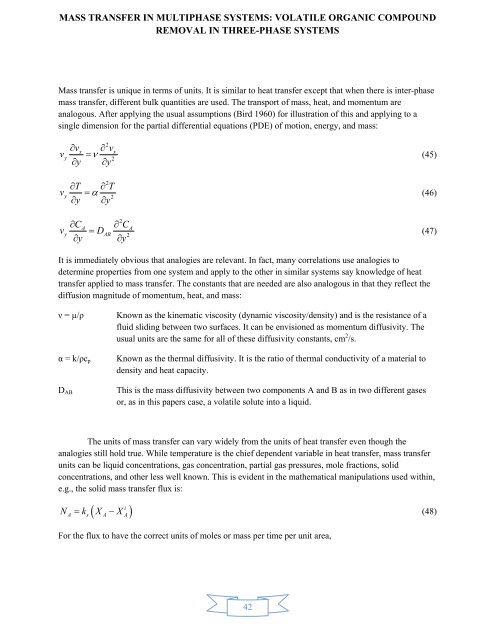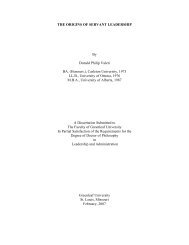mass transfer in multiphase systems - Greenleaf University
mass transfer in multiphase systems - Greenleaf University
mass transfer in multiphase systems - Greenleaf University
Create successful ePaper yourself
Turn your PDF publications into a flip-book with our unique Google optimized e-Paper software.
MASS TRANSFER IN MULTIPHASE SYSTEMS: VOLATILE ORGANIC COMPOUND<br />
REMOVAL IN THREE-PHASE SYSTEMS<br />
Mass <strong>transfer</strong> is unique <strong>in</strong> terms of units. It is similar to heat <strong>transfer</strong> except that when there is <strong>in</strong>ter-phase<br />
<strong>mass</strong> <strong>transfer</strong>, different bulk quantities are used. The transport of <strong>mass</strong>, heat, and momentum are<br />
analogous. After apply<strong>in</strong>g the usual assumptions (Bird 1960) for illustration of this and apply<strong>in</strong>g to a<br />
s<strong>in</strong>gle dimension for the partial differential equations (PDE) of motion, energy, and <strong>mass</strong>:<br />
v<br />
y<br />
vx<br />
y<br />
v<br />
<br />
y<br />
2<br />
x<br />
2<br />
(45)<br />
v<br />
y<br />
T<br />
y<br />
2<br />
T<br />
<br />
2<br />
y<br />
(46)<br />
v<br />
y<br />
C<br />
y<br />
A<br />
D<br />
AB<br />
2<br />
C<br />
y<br />
A<br />
2<br />
(47)<br />
It is immediately obvious that analogies are relevant. In fact, many correlations use analogies to<br />
determ<strong>in</strong>e properties from one system and apply to the other <strong>in</strong> similar <strong>systems</strong> say knowledge of heat<br />
<strong>transfer</strong> applied to <strong>mass</strong> <strong>transfer</strong>. The constants that are needed are also analogous <strong>in</strong> that they reflect the<br />
diffusion magnitude of momentum, heat, and <strong>mass</strong>:<br />
ν = µ/ρ<br />
α = k/ρc p<br />
D AB<br />
Known as the k<strong>in</strong>ematic viscosity (dynamic viscosity/density) and is the resistance of a<br />
fluid slid<strong>in</strong>g between two surfaces. It can be envisioned as momentum diffusivity. The<br />
usual units are the same for all of these diffusivity constants, cm 2 /s.<br />
Known as the thermal diffusivity. It is the ratio of thermal conductivity of a material to<br />
density and heat capacity.<br />
This is the <strong>mass</strong> diffusivity between two components A and B as <strong>in</strong> two different gases<br />
or, as <strong>in</strong> this papers case, a volatile solute <strong>in</strong>to a liquid.<br />
The units of <strong>mass</strong> <strong>transfer</strong> can vary widely from the units of heat <strong>transfer</strong> even though the<br />
analogies still hold true. While temperature is the chief dependent variable <strong>in</strong> heat <strong>transfer</strong>, <strong>mass</strong> <strong>transfer</strong><br />
units can be liquid concentrations, gas concentration, partial gas pressures, mole fractions, solid<br />
concentrations, and other less well known. This is evident <strong>in</strong> the mathematical manipulations used with<strong>in</strong>,<br />
e.g., the solid <strong>mass</strong> <strong>transfer</strong> flux is:<br />
<br />
i<br />
A s A A<br />
<br />
N k X X<br />
(48)<br />
For the flux to have the correct units of moles or <strong>mass</strong> per time per unit area,<br />
42



